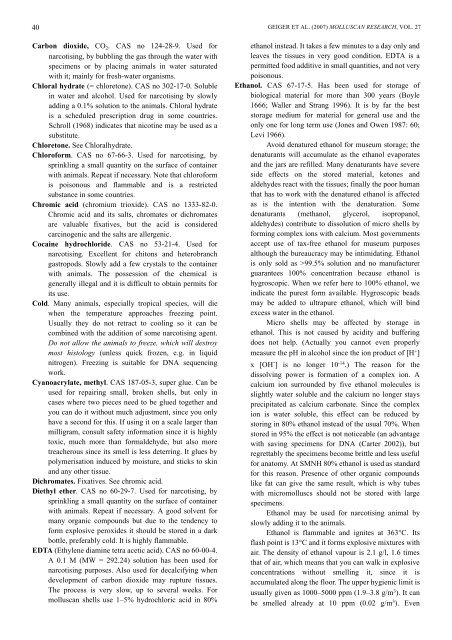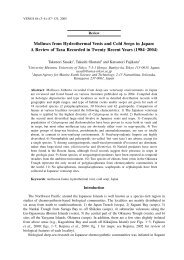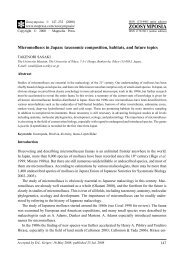Molluscan Research: Techniques for collecting, handling, preparing ...
Molluscan Research: Techniques for collecting, handling, preparing ...
Molluscan Research: Techniques for collecting, handling, preparing ...
Create successful ePaper yourself
Turn your PDF publications into a flip-book with our unique Google optimized e-Paper software.
40<br />
Carbon dioxide, CO 2 . CAS no 124-28-9. Used <strong>for</strong><br />
narcotising, by bubbling the gas through the water with<br />
specimens or by placing animals in water saturated<br />
with it; mainly <strong>for</strong> fresh-water organisms.<br />
Chloral hydrate (= chloretone). CAS no 302-17-0. Soluble<br />
in water and alcohol. Used <strong>for</strong> narcotising by slowly<br />
adding a 0.1% solution to the animals. Chloral hydrate<br />
is a scheduled prescription drug in some countries.<br />
Schroll (1968) indicates that nicotine may be used as a<br />
substitute.<br />
Chloretone. See Chloralhydrate.<br />
Chloro<strong>for</strong>m. CAS no 67-66-3. Used <strong>for</strong> narcotising, by<br />
sprinkling a small quantity on the surface of container<br />
with animals. Repeat if necessary. Note that chloro<strong>for</strong>m<br />
is poisonous and flammable and is a restricted<br />
substance in some countries.<br />
Chromic acid (chromium trioxide). CAS no 1333-82-0.<br />
Chromic acid and its salts, chromates or dichromates<br />
are valuable fixatives, but the acid is considered<br />
carcinogenic and the salts are allergenic.<br />
Cocaine hydrochloride. CAS no 53-21-4. Used <strong>for</strong><br />
narcotising. Excellent <strong>for</strong> chitons and heterobranch<br />
gastropods. Slowly add a few crystals to the container<br />
with animals. The possession of the chemical is<br />
generally illegal and it is difficult to obtain permits <strong>for</strong><br />
its use.<br />
Cold. Many animals, especially tropical species, will die<br />
when the temperature approaches freezing point.<br />
Usually they do not retract to cooling so it can be<br />
combined with the addition of some narcotising agent.<br />
Do not allow the animals to freeze, which will destroy<br />
most histology (unless quick frozen, e.g. in liquid<br />
nitrogen). Freezing is suitable <strong>for</strong> DNA sequencing<br />
work.<br />
Cyanoacrylate, methyl. CAS 187-05-3, super glue. Can be<br />
used <strong>for</strong> repairing small, broken shells, but only in<br />
cases where two pieces need to be glued together and<br />
you can do it without much adjustment, since you only<br />
have a second <strong>for</strong> this. If using it on a scale larger than<br />
milligram, consult safety in<strong>for</strong>mation since it is highly<br />
toxic, much more than <strong>for</strong>maldehyde, but also more<br />
treacherous since its smell is less deterring. It glues by<br />
polymerisation induced by moisture, and sticks to skin<br />
and any other tissue.<br />
Dichromates. Fixatives. See chromic acid.<br />
Diethyl ether. CAS no 60-29-7. Used <strong>for</strong> narcotising, by<br />
sprinkling a small quantity on the surface of container<br />
with animals. Repeat if necessary. A good solvent <strong>for</strong><br />
many organic compounds but due to the tendency to<br />
<strong>for</strong>m explosive peroxides it should be stored in a dark<br />
bottle, preferably cold. It is highly flammable.<br />
EDTA (Ethylene diamine tetra acetic acid). CAS no 60-00-4.<br />
A 0.1 M (MW = 292.24) solution has been used <strong>for</strong><br />
narcotising purposes. Also used <strong>for</strong> decalcifying when<br />
development of carbon dioxide may rupture tissues.<br />
The process is very slow, up to several weeks. For<br />
molluscan shells use 1–5% hydrochloric acid in 80%<br />
GEIGER ET AL. (2007) MOLLUSCAN RESEARCH, VOL. 27<br />
ethanol instead. It takes a few minutes to a day only and<br />
leaves the tissues in very good condition. EDTA is a<br />
permitted food additive in small quantities, and not very<br />
poisonous.<br />
Ethanol. CAS 67-17-5. Has been used <strong>for</strong> storage of<br />
biological material <strong>for</strong> more than 300 years (Boyle<br />
1666; Waller and Strang 1996). It is by far the best<br />
storage medium <strong>for</strong> material <strong>for</strong> general use and the<br />
only one <strong>for</strong> long term use (Jones and Owen 1987: 60;<br />
Levi 1966).<br />
Avoid denatured ethanol <strong>for</strong> museum storage; the<br />
denaturants will accumulate as the ethanol evaporates<br />
and the jars are refilled. Many denaturants have severe<br />
side effects on the stored material, ketones and<br />
aldehydes react with the tissues; finally the poor human<br />
that has to work with the denatured ethanol is affected<br />
as is the intention with the denaturation. Some<br />
denaturants (methanol, glycerol, isopropanol,<br />
aldehydes) contribute to dissolution of micro shells by<br />
<strong>for</strong>ming complex ions with calcium. Most governments<br />
accept use of tax-free ethanol <strong>for</strong> museum purposes<br />
although the bureaucracy may be intimidating. Ethanol<br />
is only sold as >99.5% solution and no manufacturer<br />
guarantees 100% concentration because ethanol is<br />
hygroscopic. When we refer here to 100% ethanol, we<br />
indicate the purest <strong>for</strong>m available. Hygroscopic beads<br />
may be added to ultrapure ethanol, which will bind<br />
excess water in the ethanol.<br />
Micro shells may be affected by storage in<br />
ethanol. This is not caused by acidity and buffering<br />
does not help. (Actually you cannot even properly<br />
measure the pH in alcohol since the ion product of [H + ]<br />
x [OH - ] is no longer 10 -14 .) The reason <strong>for</strong> the<br />
dissolving power is <strong>for</strong>mation of a complex ion. A<br />
calcium ion surrounded by five ethanol molecules is<br />
slightly water soluble and the calcium no longer stays<br />
precipitated as calcium carbonate. Since the complex<br />
ion is water soluble, this effect can be reduced by<br />
storing in 80% ethanol instead of the usual 70%. When<br />
stored in 95% the effect is not noticeable (an advantage<br />
with saving specimens <strong>for</strong> DNA (Carter 2002)), but<br />
regrettably the specimens become brittle and less useful<br />
<strong>for</strong> anatomy. At SMNH 80% ethanol is used as standard<br />
<strong>for</strong> this reason. Presence of other organic compounds<br />
like fat can give the same result, which is why tubes<br />
with micromolluscs should not be stored with large<br />
specimens.<br />
Ethanol may be used <strong>for</strong> narcotising animal by<br />
slowly adding it to the animals.<br />
Ethanol is flammable and ignites at 363°C. Its<br />
flash point is 13°C and it <strong>for</strong>ms explosive mixtures with<br />
air. The density of ethanol vapour is 2.1 g/l, 1.6 times<br />
that of air, which means that you can walk in explosive<br />
concentrations without smelling it, since it is<br />
accumulated along the floor. The upper hygienic limit is<br />
usually given as 1000–5000 ppm (1.9–3.8 g/m 3 ). It can<br />
be smelled already at 10 ppm (0.02 g/m 3 ). Even




